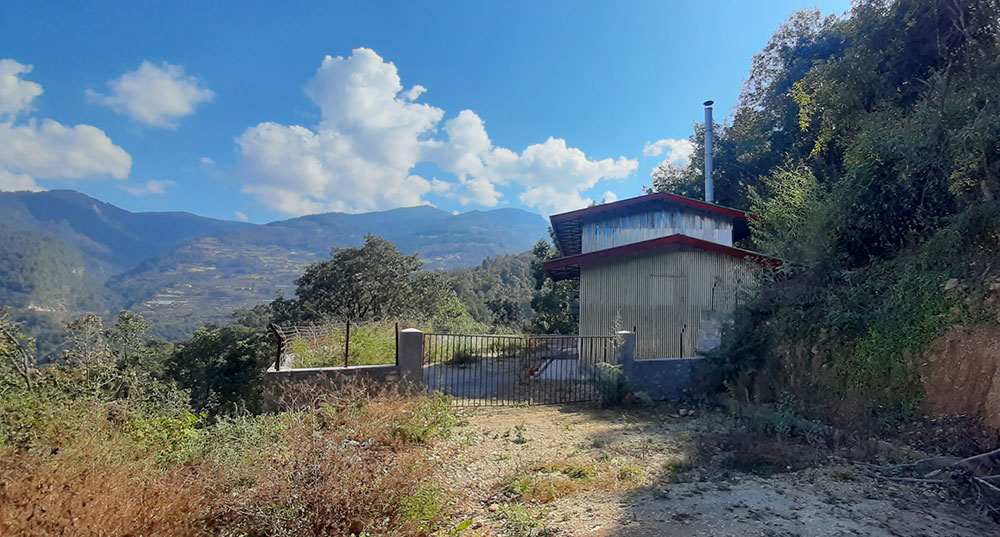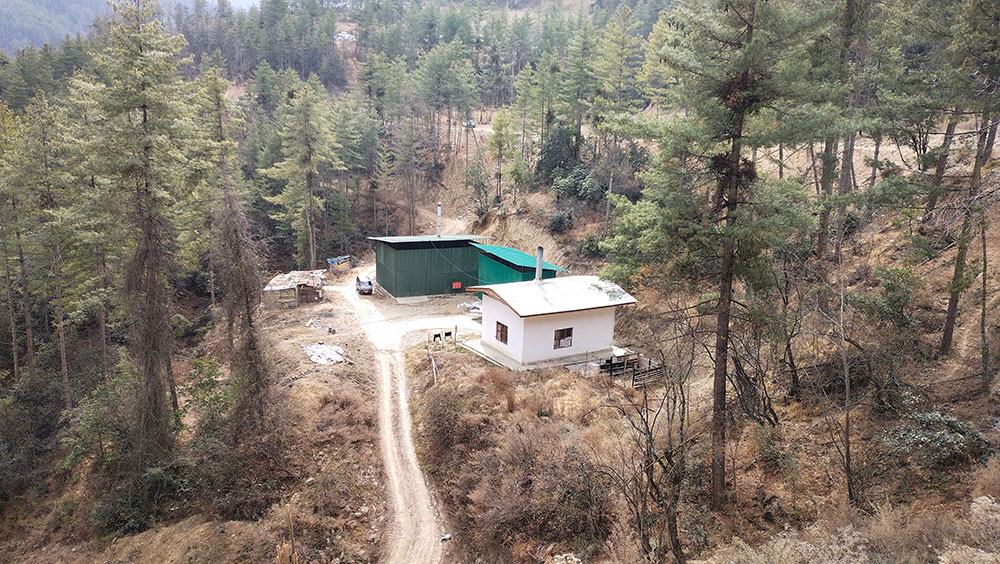Ugyen Dorji
Recognising the importance of proper disposal of medical waste, a medical waste incinerator was installed in December 2022 below the Konbar farm road, about a 10-minute drive from Mongar town.
However, since its completion, it has remained neglected and unused – surrounded by thickets serving as a gathering place for adventurous lovers, evidenced by discarded condoms and packets of emergency pills strewn around.
The facility stands neglected and underutilised, marred by structural issues and a lack of clear directives for operation. The wall of the facility has developed cracks, and the structure appears almost haunted.

The medical waste incinerator below the Konbar farm road in Mongar remains off-duty
Initially, the facility was intended to be installed in Gelephu, but due to challenges in designating the land and objections from the community, the incinerator was relocated to Mongar.
A project engineer, requesting anonymity, highlights the absence of clear operational guidelines as a major hindrance to the facility’s utilisation. Despite its capacity to handle 300 kilograms of waste in a 12-hour cycle, the lack of directives has rendered the machines dormant. The site engineer said the 100-meter approach road, cooling tank, boundary fencing, water supply, and electricity, among other structures, have been constructed at a cost of Nu 5.8 million excluding the cost of the incinerator out of the approved budget of Nu 6.20 million.
The then National Environment Commission (NEC) initiated the construction carried out by the Mongar dzongkhag under the Waste Management Flagship Program.
Mongar Dzongkhag Health Officer (DHO), Deki Phuntsho, who has now been transferred to the headquarters, said that the ownership of the incinerator has been taken over by the dzongkhag.
The dzongkhag health sector has supported the project in procuring clearances and identifying the land.
Deki Phuntso said that they had to collect expired drugs from the Basic health units (BHUs) and seek permission from the dzongkhag to use the incinerator.The municipality would initiate the work, and when there are expired grocery items in the market, the Bhutan Food and Drug Authority would collect and burn them, he said.
The facility also incinerated carcasses of animals infected with diseases. Expired drugs were buried before the completion of the incinerator. After the facility was installed, a truckload of medical waste was incinerated every two to three years.
What happened?
The time taken to incinerate waste and the cost of fuel is attributed to the neglect of the facility. According to Deki Phuntsho, the incinerator takes one whole day to burn the waste and consumes a lot of fuel.
The dzongkhag decided to use the incinerator for burning expired drugs and grocery items from six eastern dzongkhags. “But a bucket full of waste took the whole day and consumed a lot of fuel,” he added.
A technician was trained to use the incinerator and a caretaker was also appointed.
Deki Phuntso said that when NEC provided the incinerator to the dzongkhag, the idea was to use electricity to fuel it without emitting smoke. However, when we operated it, it consumed a lot of fossil fuel.
The incinerator’s operational costs, primarily run on fossil fuel, deterred potential users from embracing its services. Even the Referral Hospital in Mongar opts for alternative waste management methods, deeming the incinerator redundant
A pay-and-use system was proposed to the dzongkhag administration, but people were not willing to pay for burning their waste.
A Mongar hospital official said that the hospital has its waste management system in place, which autoclaves all the infectious waste and then dumps it.
He said that pathological waste like placentas have a separate deep burial pit near the hospital area, and the anatomical parts after surgery also have a separate place to bury. “We do not need the incinerator.”
The incinerator was planned to be installed during the pandemic, but it didn’t arrive on time. During Covid-19 pandemic, the hospital in collaboration with the dzongkhag health sector created a burning area in the landfill. If it (incinerator) was established during the pandemic, we could have used it and it could have benefited a lot, said the official.
“The incinerator is not user-friendly. Users have to carry their fuel and incinerate it, and many government agencies like us, don’t have a budget allocated to purchase fuel.”
Memelakha incinerator
Meanwhile, the Memelakha incinerator has also been dysfunctional for a year. Since its construction, the facility has only been in operation for two to three months, Kuensel learned.
There was an operator or caretaker appointed when it was installed, but now there is no one to take care. The waste is stored in the storeroom. The medical waste incinerator is located near the NEC incinerator, which has been dysfunctional for about two and a half months.
The caretaker of the facility said that the machine’s motor and fan are dysfunctional.
Phuntsholing incinerator
This incinerator in Phuentsholing had been out of use for nearly eight months.
Officials said it is costly and the facility has been used only thrice after it was installed.
While burning the waste, both electricity and fossil fuel have to be used, making it costly, said an official. He said that the facility incinerated about 900kgs of waste after its installation. The expenditure, he said, was about Nu 10,000.
A Phuentsholing Thromde official said that there is no clear standard operating procedure for operating the machine. “There is no clear ownership and clear directives from where to purchase spare parts when the machine malfunctioned. We do not have a way forward.”
The NEC received USD 374,000 from the United Nations Development Programme (UNDP) to purchase three incinerators that can burn 300kg of waste per cycle and train operators.
The incinerator supplier, Chimi Dorji, proprietor and General Manager of Jamyang Pump, said that the Thimphu and Phuentsholing incinerators have broken down and are now left idle.
He said that if the NEC places supply orders and agrees on payment terms, they could procure spare parts by the end of February or mid-March.
“The problem arose during the tendering process at the NEC, where there were changes in staff, with around two to three focal people who directly dealt with us being replaced,” he said.
As far as my company is concerned, the issue was exacerbated by the departure of the individual responsible for installing the machines, Chimi Dorji said.
He said that he is trying to manage the situation with a technician from his company, consulting with Chinese counterparts. “But changing officials at the NEC is a big challenge.”
An official from the Department of Environment and Climate Change said that there was no official communication sent to the department.


